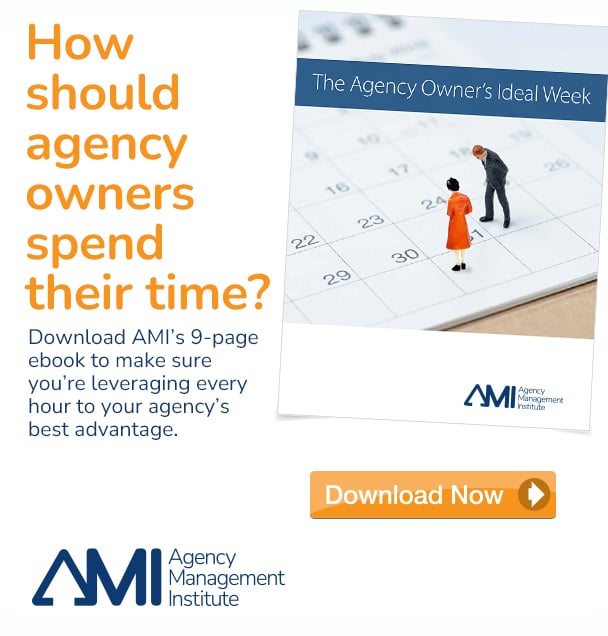The only constant in life is change, and man, does that apply to our world and agency life. The truth is – it’s not going to suddenly get easier, slower or less jarring. If anything, it’s just going to get a little quicker. So buckle up.
I have been in a unique position, because of my work with hundreds of agencies, to see these changes firsthand and want to share with you where I think our industry is headed.
Our customers today aren’t just looking for someone to manage an ad campaign or make a media buy, they are looking for partners. Strategic partners who get business. While most of the “stuff” that we create can be commoditized, what makes us different and what can’t be commoditized is our ability to think strategically.
The game has changed and agencies that are able to successfully partner with their customers beyond marketing and delve into the sales and customer service arenas are the ones that are succeeding. Learn how your agency can embrace change and succeed in these arenas by answering:
- Why the speed of change is the new normal and why you have to embrace that
- How what agencies sell has changed from the Mad Men days to today
- Why you need to tie marketing, sales, and customer service together to be a great agency today
- Why data analysis is more important than it ever has been
- Leads, sales, and retention: why you need to focus on these at a much higher level if you want to keep charging a premium price
- The importance of making real time decisions and adapting based on data
- Why we need to work with clients who may be resistant to experimentation
- How to assess if your agency is up to par on these ideas, and what to do about it if the answer is no
Drew McLellan is the Top Dog at Agency Management Institute. For the past 21 years, he has also owned and operated his own agency. Drew’s unique vantage point as being both an active agency owner and working with 250+ small- to mid-size agencies throughout the year, give him a unique perspective on running an agency today.
AMI works with agency owners by:
- Leading agency owner peer groups
- Offering workshops for owners and their leadership teams
- Offering AE bootcamps
- Conducting individual agency owner coaching
- Doing on-site consulting
- Offering online courses in agency new business and account service
Because he works with those 250+ agencies every year — he has the unique opportunity to see the patterns and the habits (both good and bad) that happen over and over again. He has also written two books and been featured in The New York Times, Entrepreneur Magazine, and Fortune Small Business. The Wall Street Journal called his blog “One of 10 blogs every entrepreneur should read.”
To listen – you can visit the Build A Better Agency site (https://agencymanagementinstitute.com/drew-mclellan-solocast-episode-11/) and grab either the iTunes or Stitcher files or just listen to it from the web.
If you’d rather just read the conversation, the transcript is below:
Table of Contents (Jump Straight to It!)
- Why Frequent Change is the New Norm for Agencies
- How Today’s Best Agencies Tie all 3 Parts of a Client’s Business Together
- How Embracing Change Allows Agencies to Charge a Premium for their Work
- Why Data Analysis is More Important than Ever
- Why Your Clients Need to Know Experimentation is Happening
- Immediate Action Steps for Embracing Change in Your Agency
If you’re going to take the risk of running an agency, shouldn’t you get the benefits, too? Welcome to Build a Better Agency, where we show you how to build an agency that can scale and grow with better clients, invested employees, and, best of all, more money to the bottom line. Bringing his 25 plus years of expertise as both an agency owner and agency consultant to you. Please welcome your host, Drew McLellan.
Drew: Hey there, everybody. Drew McLellan here with another episode of Build a Better Agency. This week’s episode is a solocast. So no guest this week. Just you and me chatting about something that I think needs to be on your radar screen.
And as I was thinking about preparing for today’s solocast, I just had a conversation with several agency owners about the speed of change and how it seems like, for those of us who are old dogs and have been in the business for 20, 25 years, that the rate and frequency of change inside our industry is just growing exponentially.
And, you know what? I think that that’s the new normal. And I think one of the things that makes someone a great agency person, whether it’s an employee or an owner, is that you are someone who embraces change and likes the challenge of new and different. And, well, you know what? Our world today is handing that to us, in spades.
Why Frequent Change is the New Norm for Agencies
So I want to talk a little bit about some of the changes that I’m seeing across the swath of agencies that AMI works with and across the industries as a whole, as I talk to other folks in the business. When you think about the way our industry started, go back to the Mad Men days. Really what we did in the beginning if we were an agency is we sold media, and we gave away all of our best ideas, and we made stuff, ads, for free. All in exchange for the media commission. And that’s the way agencies made their money.
And so we got used to, and we created a culture around, coming up with the absolute best creative regardless of how much time it took. And when you hear that sentence today you think, “That’s crazy. I can’t do that today.”
Well, the reason why you can’t do that today is that we shifted away from just selling media, and giving away our ideas, and making stuff for free to then, as advertising turned into marketing and we got into things that weren’t tied to paid media. Then we started selling our stuff.
So whether it was we were making advertising, radio spots, TV spots, print ads. Or we were creating brochures, or outdoor boards, or trade show booths, or whatever it might be. We were making stuff and that was what we sold. And we were in an era then where we gave away a lot of our marketing strategy to get the work.
To get the job where we would be able to sell the stuff. We’d make the stuff and we got paid for our time. And then, in many cases, we marked up all the out of pockets that were tied to that. So that’s how we made our money back then. It wasn’t on our ideas, it was more on our stuff.
But as computers became commonplace and as everyone thought of themselves as a publisher all of a sudden, the stuff we make, sometimes, feels like it’s a commodity. And now I think agencies are in this weird quandary place where many agencies still make and sell a lot of stuff. Right? A lot of marketing materials or advertising.
But we’re also trying to sell our ideas. We recognize, now…and for some of you, you may have been on this train for a long time and for others this is new. We recognize that really what makes us different, what cannot be commoditized, is our ability to think strategically. To understand audiences. To understand how to create messaging and personas. And to help our clients with our outside perspective.
I like to think of agencies as outside insiders. You know enough to be really helpful but you are not so biased by what’s happening inside the organization that you can’t see the bigger picture.
But now the question is, “How do I sell both my stuff, that we’re making still? But also, how do I get paid for the ideas and the strategy?” And some agencies have knocked this out of the park and other agencies are still struggling with this. For some agencies, as they move into a more consultative mode, now all of the sudden you’re bumping into and against the consulting firms, the Deloittes of the world, who are also trying to get into that same game with our clients by selling them strategy.
How Today’s Best Agencies Tie all 3 Parts of a Client’s Business Together
One of the ways that I have seen agencies really knock it out of the park, are the agencies that are able to tie three parts of a client’s business together. Three parts that we’ve always talked about as how tangentially they’re related. But oftentimes, traditionally, agencies have not gotten involved in those. And that is marketing as one entity, sales as another entity, and customer service as the third entity.
And agencies that have figured out how to help clients knit those three together…so creating marketing, but following that marketing all the way into the sales channel and funnel, and then following that sales lead into a sale, and then following that sale into conversion to an elated customer who becomes a raving fan.
When an agency has their fingers in all of that…and by the way, so now you’re not just making advertising. You’re making marketing materials. You’re creating marketing strategy. You’re creating audience strategy and messaging. You are doing all of the Lead Gen things that you are uniquely qualified to do but you’re also working with the sales team and helping them be better at sales. You’re making sure that the sales funnel doesn’t have any holes in it that people can move seamlessly from one level to another in the sales funnel.
And then you are also helping your clients track what happens after the sale. So how are they following up? How are they responding to reviews and ratings? How are they answering customer complaints? Are they offering live chat on their website? Whatever it is, all of the sudden agencies are getting involved in all of that.
And when you can say to a client, “Look, we are literally going to help you define who your audience is, why they should care about your product or service, and help you figure out ways to talk to them in ways that are relevant enough that they allow you to stay in their space. So they’re not booting us out, they’re not unsubscribing, they’re not tuning us out, until they are ready to engage in the sales process. And then we’re going to help you manufacture that sales process so that it is a delightful experience for your prospect and that they love shopping with you. They want to buy from you. They don’t feel pressured, all of that stuff.
So helping influence the sales process and client. We are then going to help you not only make that first sale but connect to that new customer in a way that creates repeat business, and raving fan behavior, and great ratings and reviews. And all of those things. Now we are absolutely influencing that entire ecosystem of the customer. And now it’s pretty hard for us to be irrelevant to your business.”
How Embracing Change Allows Agencies to Charge a Premium for their Work
Agencies that are doing that are the agencies that are charging a premium for what they do and are not only charging a premium for what they do, but their clients are coming back to them and saying, “I know that our budget was $100 in this last year but based on what you’ve been able to show us…”
Because, by the way, part of this is being able to say to them, “Look, for every dollar we spent, you made $3, right? Between the new customers and repeat business of existing customers. So I know we spent $100 this year but based on the data that you’ve shown us, I want to spend $200 in this coming year.”
That’s what’s happening to the agencies that have mastered this suite of services that cover the broader spectrum of the customer experience. “From the first time, I’ve heard about you,” to “I’m buying for the 20th time.” And the reason that this is working for agencies is that the game has changed. So the reality now is that data drives so much of marketing. And you need data today to generate ideas that are useful to your client.
So one of the things that’s happening inside agencies is that your analyst, your data crunchers, your nerds are the cool kids inside the agency. They’re the ones who are often helping to generate the big idea, the big sale.
Which is causing, as you might imagine, some struggles in some agencies. And we’ve talked about this before when I talked about stale employees. It’s causing some trouble amongst the employees who are traditional and are not choosing…because everyone can do this…are not choosing to convert themselves into being more data driven. And with that it seems like a really great to take a brief pause, and then we will get right back to the show.
I just wanted to take a quick pause and remind you that, on top of the podcast, we also do a lot of live workshops for agency owners, agency leaders, and account service staff. If you’re interested in the schedule, check it out at agencymanagementinstitute.com/live.
Let’s get back to the show.
Why Data Analysis is More Important than Ever
So we’re more data driven. The CMOs are being held to results. More than ever before in the history of our business are our customers, our clients being held to delivering results. It’s not enough anymore to run a great brand campaign. It is not enough anymore to have awareness. It really does…for the CMO to keep their job, it boils down to leads, and sales, and retention.
And we have got to get into that game and have to play it at a much higher level than many agencies are playing it today. If you want to keep charging a premium price, and you want to be able to continue to grow the existing clients you have, and attract the new clients. So all of this data driven marketing that we’re doing, all of this going from the first time a prospect is ever heard of the product, to repeat business, it’s a little more challenging than just creating a brand ad. So now you’re really being held accountable to results.
And oftentime, the more we can get involved with the client and influence the entire process the better our results are. How many times have you said, “We drive so many leads into the clients but their sales department can’t handle them or doesn’t follow up.” Or fill in the blank. Well, guess what? We can’t stand on the sidelines and grouse about that, anymore. We have to get into the game and we have to help those salespeople be better at what they do. We have to influence the entire process.
So what that means is the way we work is, quite honestly, a little messier. It’s more experimentation. With data comes experimentation. We’re able to try things and then see if they’re working or not, and then make adjustments.
It’s not set it and forget it like it used to be in the Mad Men days. You would buy a 13-week campaign or a 26-week campaign. You’d throw the media buy out there. You’d throw the creative out there. And then you sat back and let it to do its job. That’s not our reality anymore.
Our reality today is that our clients have data, or they want us to have data, that helps them makes real-time decisions about what’s working and what’s not. And we have to help them find the balance of not being too reactionary but, also, not being too sedentary. Not sitting for too long and not changing a headline, or a visual, or whatever it may be based on the data that’s in front of us.
Why Your Clients Need to Know Experimentation is Happening
One of the things that I think we have to get better about with clients is helping them understand that there is more experimentation happening. Because a lot of us, our clients are 50 plus and they’re used to the good old days of marketing. So this idea of experimenting, and evolving a campaign, and changing things on the fly, that’s not naturally comfortable for them.
So you’re gonna have to work with them to help them understand why we’re doing it, the benefits of doing it, and how to get comfortable. Not only themselves, but selling that up into the C suite as they are evolving campaigns faster than the organization is used to.
It’s a little bit like improv. So it is very different than how we used to do our work. It really is now about this brand improv of, “How do I pay attention to what tweets people are reacting to? Or what’s happening on Facebook? Or who’s sharing what on Instagram? Who’s clicking on what ads?” All of those things, we have all this data now all of the sudden. “What’s our open rate and does the headline change that?”
All of these data points allow us to pinpoint a better way to serve up leads and sales for our clients, but we have to get comfortable around it. So I think one of the challenges that’s coming up for all of us is, “How do I structure my business to be more data driven? How do I structure my business to be involved in a client’s marketing, and sales, and customer relationships? How do I build a team that’s good at that?”
And, by the way, building a team doesn’t necessarily mean they all sit in your office every day. Many of you have moved into a hybrid model where you are keeping a core staff together. And it could be a big staff, could be 150 or 200 people. But you are still bringing specialists in from the outside, as you need them.
“So how do I structure it? How do I get paid? How do I monetize this? Do I tie it to leads and sales?” Well, that’s a dangerous proposition if you’re not also involved in the sales and customer service part of the business. That feels a little more comfortable if you are actively influencing the entire spectrum.
And, “How do I reinvent my agency? How do I reinvent my people to be thinking this way?” These are the challenges that are facing us right now as our clients are demanding more from us in terms of the sales cycle, in terms of keeping and connecting with customers as well as prospects. And I think one of the new frontiers for many of us is getting actually into the sales game.
Immediate Action Steps for Embracing Change in Your Agency
So I want you to think about all of these things. And I want you to look at your team. And I want you to think about, “Are we capable right now, today, of serving our clients in those three arenas?” In the marketing, sales, and customer service arena.
“Do we know what we need to know about ratings and reviews? Do we have the ability to go in and audit a client and help them understand how they are or are not taking advantage of what’s being said about them online. Are we helping our clients monitor and listen to what’s being said? Are we managing their online reputation? Are we helping their sales team understand how to have conversations in this new plugged in era, and connected era?”
It’s very different, especially if the sales force is older or more traditional. That’s the question we have to ask is, “Are we equipped to do this?” I don’t think there’s any question that this is where your agency is headed. And some of you may be running to this new change. And some of you may be dragging your feet and kicking and screaming.
But I’m telling you, your customers, your clients, are demanding and, frankly, they need more help in these arenas. And if you want to be their trusted partner…you don’t want to be a vendor, you want to be sitting at the C suite table with them, then you’ve got to wrap your arms around, “How do I bring my agency into these three connected parts of my client’s business? And how do we help them move someone all the way through this funnel and then keep them happy and content at the end of the funnel for a long, long time?” That’s the challenge that’s in front of us.
And for every agency the answers are going to be a little different. Because you may have somebody on staff who’s a crackerjack at rating and review already. You may have a staff of older, traditional creatives who really need to kick into gear if they’re going to stay relevant to your clients tomorrow, or three years from now.
So what I want you to do as you are listening to me through this podcast is I want you to go back and I want you to listen to it again with your staff. And I want you guys to have a really candid, good conversation about where you’re already great and where you need to shore up your abilities.
And how do you start talking to clients? And I would start with some of your current clients, some of your best clients about starting to tiptoe or seep into the other aspects of their business that you have not traditionally been touching. And how do upsell into that and use them as your training ground to really test your team.
And, by the way, even you, if you’re the owner, test your entire team in terms of how well you can deliver this and then figure out what holes you have and how to plug those holes. I promise you that this is where your agency is headed and I want to make sure that you are heading in the right direction with the right team, the right proposal templates, the right offerings.
Because more and more today the agencies that are driving to leads and sales, and then nurturing those leads and sales so they become repeat sales, are the agencies that are being retained year after year, and are able to charge a premium price for what they do.
That, my friends, is the state of our agencies today. And I’m hoping that this was helpful to you. I’m hoping it gets you thinking. I’m hoping it actually gets you excited. This is new ground for many agencies and it’s exciting new ground. You can really have huge impact on your clients and their business. And it’s rewarding work and you can be well rewarded for it.
So with that, I’m gonna let you ponder on that for a bit. If you have questions about this or you want to chat about it? You know how to reach me at [email protected].
I will be back next week with another podcast. Next week I’ll have a guest with me talking about their area of expertise and helping us focus on how to build a better, stronger, more profitable agency.
Until then, would love to have you pop over to iTunes, or Stitcher, or Google and leave us a rating or a review. Super helpful for people to find us. The more that happens, the more we get on other people’s radar screen which is important to me. So I would be grateful if you would help with that.
Thanks very much for listening and I will catch you next week.
That’s all for this episode of Build a Better Agency. Be sure to visit agencymanagementinstitute.com to learn more about our workshops and other ways we serve small to mid-sized agencies. While you’re there, sign up for our e-newsletter, grab our free eBook, and check out the blog. Growing a bigger, better agency that makes more money, attracts bigger clients, and doesn’t consume your life is possible here on Build a Better Agency.






